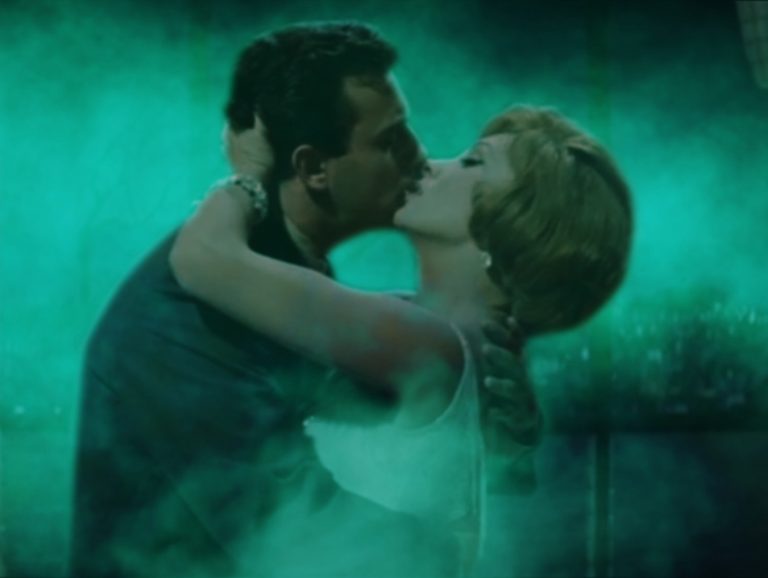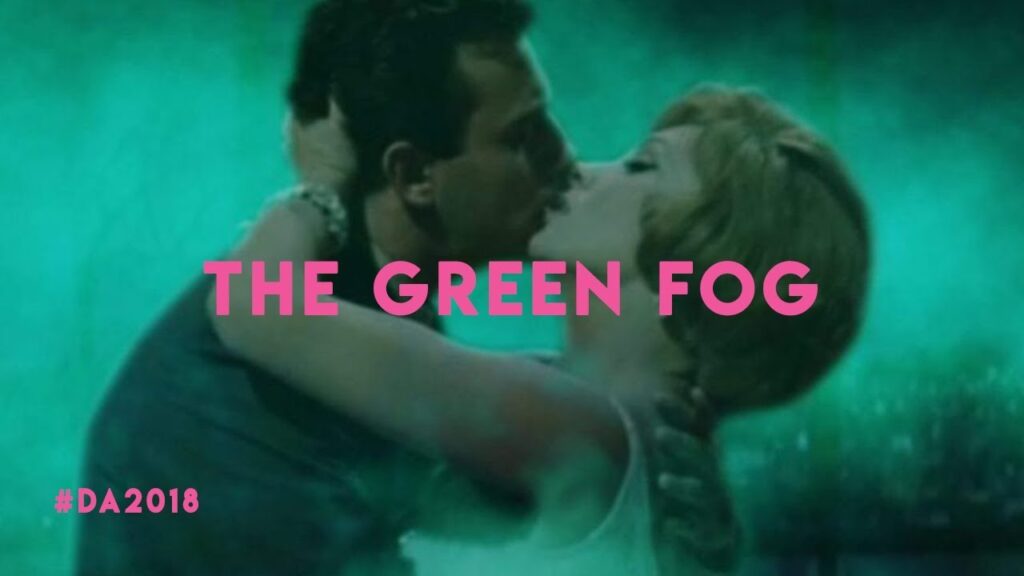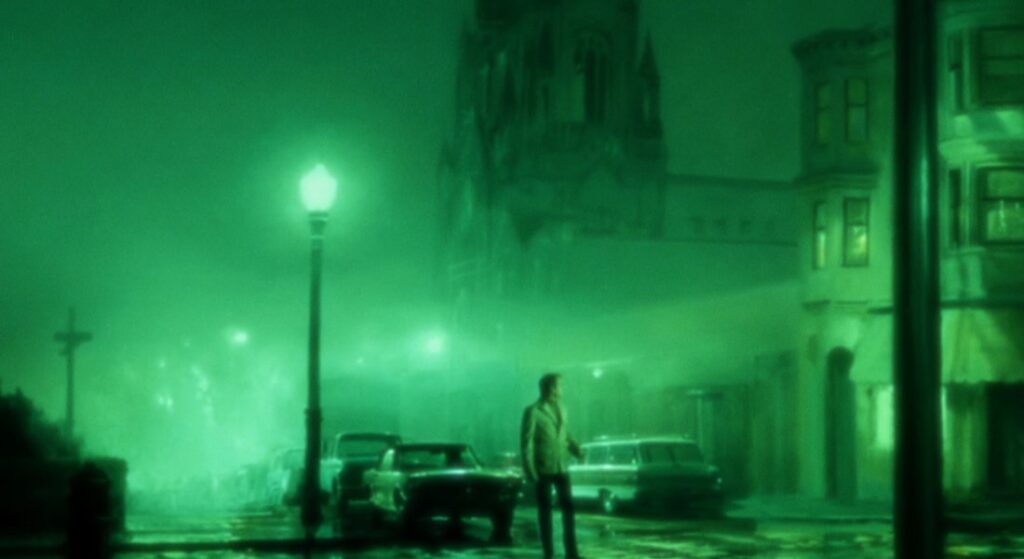From the March 2019 issue of Found Footage. — J.R.

As a critical commentary on cinematic depictions of San Francisco, Guy Maddin’s The Green Fog, conventional match cuts that approximates Scotty’s tailing of Madeleine as various cars follow various other cars down assorted San Francisco streets, sometimes passing locations that are familiar from Vertigo or other movies, we’re getting the bare bones of thriller and mystery mechanics without any of the thrills or mysteries, in contradistinction to all the musical signals. And when we see Karl Malden enter a florist shop, and converse (again wordlessly) with the florist, it seems appropriate that the piece of paper that the florist shows to him shows us the green fog yet again, Maddin’s signifier of the genre’s rhetoric of mystification.
For some of the Hitchcock aficionados who helped to replace Citizen Kane with Vertigo in the last ten-best poll of Sight and Sound, the affectionate ridicule of The Green Fog may seem like an act of sacrilege, especially when we get a panoply of San Francisco cathedrals that are treated as interchangeably as all the cars and streets. But it might also be argued that Maddin’s apparent scorn is in fact a kind of impious critical appreciation for all the tricks of romantic mystification that he and Hitchcock have in common. We have to bear in mind that seen in 2018, sixty years after its first release, Vertigo is already a kind of scrapbook—not only a scrapbook of famous and obscure locations in San Francisco and environs (which is part of what Chris Marker, the poet laureate of scrapbooks, is so fascinated with, paralleling some of Thom Andersen’s investment in Los Angeles), but also a scrapbook of Hitchcock Moments, past and future. A policeman reaching out his hand for a dangling Scotty to grab in the opening action sequence anticipates Cary Grant reaching out his hand for a dangling Eva Marie Saint to grab on Mount Rushmore in North by Northwest a year later. James Stewart recovering afterwards from his (unseen) accident, wearing a corset instead of his leg in a cast and complaining about being unable to scratch his itches, inevitably takes us back to Stewart in Rear Window; his gliding trip through a cemetery looks forward to Bruce Dern’s visit to one in Family Plot; and Scotty’s near-catatonia after Madeleine’s apparent suicide offers many resemblances to Vera Miles’ near-catatonia in The Wrong Man. Even more, one might say that a scrapbook entry becomes a textbook example when it comes to Hitchcock; the aforementioned 360-degree camera spin around Stewart and Novak that Hitchcock arguably cribbed and adapted from Dreyer has become a classic romantic cliché for De Palma, Schrader, and countless others. Which doesn’t mean that the underlying emotions are necessarily inauthentic or unfelt, only that they’re sufficiently shopworn to allow for a critical reading.
So even if we periodically lose track of which particular Vertigo scenes are being referenced, as I did, the overall intention to make its passions and conflicted emotions look, sound, and feel as absurd and as ridiculous as possible continues unabated. If we haven’t seen Vertigo at all, I think we can still appreciate Maddin’s unpacking of all its romantic mystifications and their various forms of punctuation—that is to say, their green fog. Although Maddin appears to use a few glancing clips from Vertigo itself—such as the red flower petals that Madeleine drops into San Francisco Bay—he makes sure to deflate them immediately, such as cutting next not to Madeleine dropping into the same Bay but to a black and white clip of a man falling with an oafish yelp into a swimming pool, and proceeding next to an underwater deep-sea-diver rescue, complete with snorkel gear, to replace Scotty’s rescue of Madeleine. And when it comes to Madeleine’s recovery in Scotty’s flat, after having been implicitly stripped naked by him before she regains consciousness, Maddin replaces Novak with Gina Lollobrigida in a slip, already awake, and adds a whole subplot about their conversation being secretly recorded on reel-to-reel tape by operatives, even though characteristically none of their bedroom conversation is heard, apart from the male actor saying, “That makes two of us”. This is because for Maddin, it’s only their portentously adoring or puzzled looks at one another that really count—to which he adds another dollop of rising green fog.
The audio surveillance may remind us that Scotty and Madeleine’s budding romance is in fact adulterous, a fact that Hitchcock either avoids or else makes even sexier by refusing to mention it (much as he refrains from showing Scotty removing Madeleine’s clothing). A master throughout Vertigo of the Kuleshov experiment, Hitchcock knows that the best way to represent romantic longings is by omission, while Maddin makes eccentric omissions of his own in order to force us to consider what it is we might be missing—and might be helping to construct as a consequence.
After the tape gets rewound, and Maddin shows us the same bedroom non-conversation in rapid reverse, Rock Hudson, one of the operatives, expresses it best. John Shuck, another operative, asks, “What are we looking for, sir?” and Hudson,still the consummate film analyst, confidently replies, “I don’t know. But at this point I’ll take anything.”


